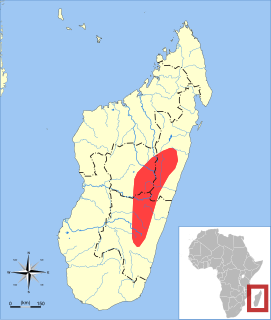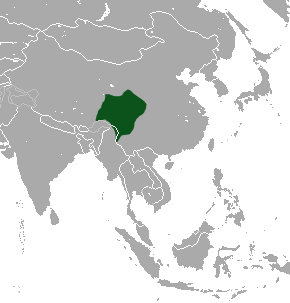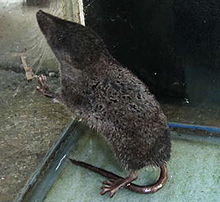
Shrews are small mole-like mammals classified in the order Eulipotyphla. True shrews are not to be confused with treeshrews, otter shrews, elephant shrews, or the West Indies shrews, which belong to different families or orders.

A tenrec is any species of mammal within the afrotherian family Tenrecidae endemic to Madagascar. Tenrecs are widely diverse; as a result of convergent evolution some resemble hedgehogs, shrews, opossums, rats and/or mice. They occupy aquatic, arboreal, terrestrial and fossorial environments. Some of these species, including the greater hedgehog tenrec, can be found in the Madagascar dry deciduous forests. However, the speciation rate in this group has been higher in humid forests.

The family Talpidae includes the moles, shrew moles, desmans, and other intermediate forms of small insectivorous mammals of the order Eulipotyphla. Talpids are all digging animals to various degrees: moles are completely subterranean animals; shrew moles and shrew-like moles somewhat less so; and desmans, while basically aquatic, excavate dry sleeping chambers; whilst the quite unique star-nosed mole is equally adept in the water and underground. Talpids are found across the Northern Hemisphere and southern Asia, Europe, and North America, although none are found in Ireland nor in the Americas south of northern Mexico.

The red-toothed shrews of the subfamily Soricinae are one of three living subfamilies of shrews, along with Crocidurinae and Myosoricinae. In addition, the family contains the extinct subfamilies Limnoecinae, Crocidosoricinae, Allosoricinae and Heterosoricinae. These species are typically found in North America, northern South America, Europe and northern Asia. The enamel of the tips of their teeth is reddish due to iron pigment. The iron deposits serve to harden the enamel and are concentrated in those parts of the teeth most subject to wear.

The American water shrew or northern water shrew, is found in the nearctic faunal region located throughout the mountain ranges of the northern United States and in Canada and Alaska. The organism resides in semi-aquatic habitats, and is known for being the smallest mammalian diver.

The marsh shrew, also known as the Pacific water shrew, Bendire's water shrew, Bendire's shrew and Jesus shrew is the largest North American member of the genus Sorex. Primarily covered in dark-brown fur, it is found near aquatic habitats along the Pacific coast from southern British Columbia to northern California. With air trapped in its fur for buoyancy, marsh shrews can run for three to five seconds on top of the water. It measures about 16 cm (6.3 in) in length, including a 7-centimetre (2.8 in)-long tail, and weighs an average of 14.5–16 g (0.51–0.56 oz). The marsh shrew's diet consists mainly of invertebrates, which it hunts on land and in the water. They are rare; their populations are thought to be in decline, and they are considered endangered in parts of their range.

The web-footed tenrec, otter shrew, or aquatic tenrec is the only known semiaquatic tenrec, and is found in eastern Madagascar, especially in and around Ranomafana National Park. It grows to between 25 and 39 cm, and was once thought to be extinct. It feeds on crabs, water insects, and crayfish. The population is considered vulnerable. It was formerly placed in the monotypic genus Limnogale, but has been moved to Microgale based on molecular data showing it to be deeply nested within the latter.

The Malayan water shrew, also known as the hantu water shrew, is a red-toothed shrew recorded only from the Malaysian state of Selangor. It was listed as a critically endangered, but is now considered near threatened.

The Sumatran water shrew is a red-toothed shrew found only in the Padang highlands of western Sumatra, Indonesia. Its natural habitats are streams in montane forests. The species is only known from a holotype, which is damaged, and was previously listed as critically endangered by IUCN. It is believed to be severely threatened by habitat loss.

Aquatic and semiaquatic mammals are a diverse group of mammals that dwell partly or entirely in bodies of water. They include the various marine mammals who dwell in oceans, as well as various freshwater species, such as the European otter. They are not a taxon and are not unified by any distinct biological grouping, but rather their dependence on and integral relation to aquatic ecosystems. The level of dependence on aquatic life varies greatly among species. Among freshwater taxa, the Amazonian manatee and river dolphins are completely aquatic and fully dependent on aquatic ecosystems. Semiaquatic freshwater taxa include the Baikal seal, which feeds underwater but rests, molts, and breeds on land; and the capybara and hippopotamus which are able to venture in and out of water in search of food.

The Himalayan water shrew is a species of mammal in the family Soricidae. It is found in China, India, Japan, Laos, Myanmar, Taiwan, and Vietnam.

The Bornean water shrew is a species of mammal in the family Soricidae. It is endemic to Malaysia. Its natural habitat is rivers. It is threatened by habitat loss.

The Japanese water shrew, also called the flat-headed water shrew, is a species of mammal in the family Soricidae. It is endemic to Japan.

The Chinese water shrew is a species of mammal in the family Soricidae. It is found in China and Myanmar.

Nectogalini is a tribe of Old World water shrews within the family Soricidae. As of late 2007, it consisted of six extant genera and 25 species, with some of the latter being further divided into subspecies.
Interdigital webbing is the presence of membranes of skin between the digits. Normally in mammals, webbing is present in the embryo but resorbed later in development, but in various mammal species it occasionally persists in adulthood. In humans, it can be found in those suffering from LEOPARD syndrome and from Aarskog–Scott syndrome.















